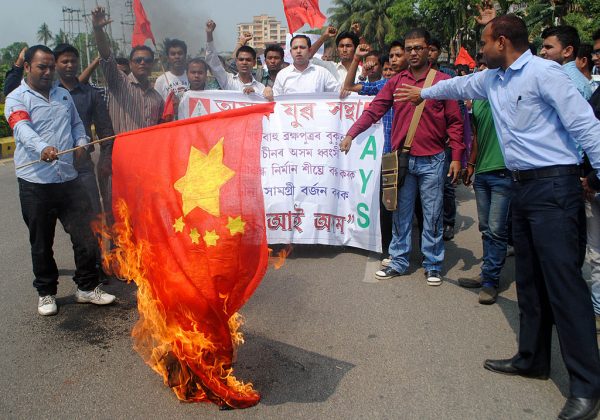The Chinese Communist Party (CCP) is not your typical totalitarian government. It is a uniquely selfish form of chaotic political control, that has always had a willingness to sacrifice not only anyone who does not align with it, but also its own people. The motto of the CCP under Mao Zedong’s Cultural Revolution was “Battle with heaven, fight with the earth, struggle with humans— therein lies endless joy.”
Decades later, this deviant approach to governance and moral philosophy has manifested as a geopolitical problem for China’s neighboring countries in the form of weaponized water.
18 countries and close to two billion people rely on a dozen rivers, which mostly originate in the Tibetan Plateau.
The most recent water battle between the communist regime and its neighbors lies with India, as the Party plans to build a dam that would dwarf the Three Gorges on the Yarlung Zangbo, a river which flows west-to-east from Tibet across China before entering the Arunachal Pradesh region of India and eventually becoming the Brahmaputra River.
According to a January article by Nikkei Asia, construction of the dam is moving ahead without China’s government (the CCP) entering into, or even discussing water sharing agreements with downstream neighbors India and Bangladesh.
Success
You are now signed up for our newsletter
Success
Check your email to complete sign up
Nikkei says the dam is slated to produce three times more hydroelectricity for the Party than the Three Gorges does.

The Yarlung Zangbo is the highest river in the world at 5,000 feet above sea level. It takes a nearly 8,000 foot plunge at the Yarlung Zangbo Grand Canyon, which makes it a delectable target for the Party’s power engineers.
The proposed dam is located just 18 miles from the Indian border.
Lessons from the Mekong
India has valid cause for concern. The CCP has placed no less than 11 dams on the Mekong River, a crucial vein in the southeast Asian region, which travels 3,000 miles from southwest China through Myanmar, Thailand, Laos, and Cambodia before emptying into the South China Sea.
The Communist Party has three additional dams for the Mekong in planning.
In April of 2020, the Stimson Center, a U.S.-based think tank, published a report titled New Evidence: How China Turned Off the Tap on the Mekong River that found in 2019 the CCP used its dams to withhold water from downstream regions as it enjoyed record precipitation.
The report relied on data from Eyes on Earth, which used satellite measurements of microwave radiation to determine water level in the region.

The Stimson Center describes the findings as an “ongoing pattern that has driven numerous wet season droughts,” adding “The increasing frequency of wet season drought in the Lower Basin tracks closely to the way China releases water during the dry season and restricts water during the wet season.”
“China is impounding much more water than it ever has in the past during wet seasons and releasing more water than ever before during the dry seasons….China’s dam management is causing erratic and devastating changes in water levels downstream.”
The report says for five months in 2019, “China’s dams held back so much water that they entirely prevented the annual monsoon-driven rise in river level at Chiang Saen, Thailand.”
“This has not happened since modern records have been kept.”
Researchers found the CCP’s motive was to replenish its dams after emptying them to produce hydroelectric power between January and June of 2019, a time when electricity was selling at a 300 percent premium in the mainland.
“The amount of rainfall and snowmelt in China was enough to keep water levels in much of the Lower Mekong above average between June 2019 and March 2020 if China’s dams were not restricting that water,” reads the report.
Domestic water problems flow from corruption
The Communist Party not only has a water problem in its dealings with surrounding countries, but also domestically. China faces an imbalance between water and population; 7 percent of the world’s freshwater to 20 percent of the world’s population, in addition to the south possessing most of the country’s water while the north is home to most of its people.
To solve its problem, the Party created the so-called South-to-North Water Diversion (SNWD) project, an array of canals and tunnels that intend to divert water from the Yangtze River towards Beijing. Two already-built routes have been operational since 2014. The eastern route directs water to Beijing through repurposing the 2,500-year-old Grand Canal, and a central route uses the Han River, a tributary of the Yangtze.
A third route is being planned in the west, intending to utilize additional dam projects from the Tibetan Plateau.
The SNWD cost $80 billion USD, displaced more than 400,000 Chinese citizens and shut down countless local industries as Party bosses attempted to reduce the pollution that the water would be subjected to (from the country’s notoriously toxic and poorly regulated industrial sector) during its 1,000 mile journey.
A 2015 study published in Nature Magazine found the SNWD was dubious from its creation, “Pollution and environmental fallout, as well as high maintenance costs and water prices, make the project unsustainable both ecologically and socially.”
“And the transfer of water does not address the underlying causes of water shortages in the north, namely pollution and inefficient agricultural, industrial and urban use – the effects of which we have been studying over the past decade.”
“North China could be self-sufficient in water without the transfer of water from the south. But the necessary steps – among them, improving local pollution monitoring and building better irrigation infrastructure – are inadequately implemented,” say the authors.
The study found the communist-controlled country’s governments focus on increasing supply to solve water scarcity is simply because of corruption, “Increasing supply is viewed as the main solution to water scarcity because of the conflicting roles of the Chinese government as both entrepreneur and regulator.”
“Incentives for economic growth in China still outweigh incentives for pollution control and limits on water extraction, despite ever stricter environmental laws.”
The paper continued, “Many industries, such as the country’s huge hydropower sector, profit from expensive solutions to boosting water supplies.”’
Even the globalist and CCP-friendly World Economic Forum was critical of the communist regime’s environmental controls and called for China’s leaders to use their heads when it comes to finding a solution in a 2016 article titled China Has a Water Crisis – How Can It be Solved?, “While industrial pollution is the most frequently discussed source of pollution, land use and degradation accounts for about half of the pollution found in China’s water. Fertilizers, pesticides, and livestock waste is carried into lakes, rivers, wetlands and coastal waters. Aquifers are also impacted as rainfall and snowmelt carry pollutants underground.”
“By protecting forests and improving agricultural practices in targeted areas in China, the country can improve water quality. In fact, by targeting conservation strategies to roughly 1.4 million hectares, sediment and nutrient pollution could be measurably reduced – by at least 10% – in these small to medium sized water catchments. These natural solutions have the potential to improve water quality for more than 150 million people.”
The WEF found that the CCP could even save itself some money if it could find a way to cast off corruption and look at the problem humanely. The article notes that the Party was spending $8 billion USD per year on “eco-compensation programs,” while water quality upgrades using natural solutions that would benefit 30 of its largest cities would cost only $300 million per year.
















